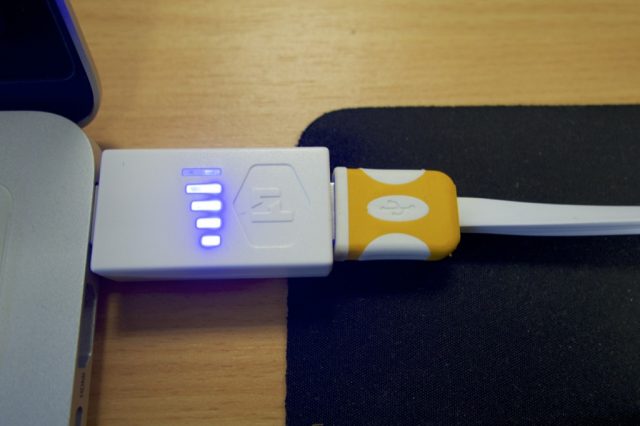
We’re all familiar with charging our gadgets via USB. I’ve known that not all USB sources deliver the same amount of power. But it came as a surprise to me, earlier this year, to learn that even the cables matter. Some cables charge slower than others. Wouldn’t it be great to know exactly how much juice is flowing to your gadget? That’s what Power Practical’s Practical Meter is for!
The Practical Meter is just like an electrical power meter. So don’t worry, you don’t have to hang around checking the before/after charge level over several hours to know how much power was flowing through. The Practical Meter will give you instantaneous power readouts.
The readouts are a little low-tech. They are a series of 5 LED bars. Each bar will light up in blue, corresponding to the number of watts of power following through. So if three LEDs light up, that means there’s 3 watts. The Practical Meter actually measures up to 10 watts. To indicate watts more than 5, the first LED blinks blue and red alternately, and in this indication mode, the number of LEDs lighting up correspond to 6 watts to 10 watts of power.
If the first LED lights up in red only, that means power is available, but nothing is being drawn. (Or, rather, less than 1 watt is drawn.)
 So as an example, in the photo above, the Practical Meter is indicating 4 watts of power being drawn. In there, my Samsung Galaxy S4 (SGS4) smartphone is charging with the Fast Charge Cable from Power Practical. A typical cheap third-party cable would have charged at just 2 watts.
So as an example, in the photo above, the Practical Meter is indicating 4 watts of power being drawn. In there, my Samsung Galaxy S4 (SGS4) smartphone is charging with the Fast Charge Cable from Power Practical. A typical cheap third-party cable would have charged at just 2 watts.
With the Practical Meter, you can now easily determine which of your USB sources deliver more power, or which of your cables allow more power through, or any combination thereof. It’s really convenient and useful.
Nowadays we own so many gadgets that use USB power to recharge their batteries. It’s important for us to keep them charged, and more often than not, we want them charged quickly. I’ve puzzled a couple of times over why something seems to take forever to charge to full capacity. The Practical Meter will give me the answer.
Many of us also buy extra third party chargers and USB cables. Now we can easily figure out which ones are better.
The Fast Charge Cable from Power Practical charges fast too. The only downside with it is that it won’t allow data connection. It’s the cable, not the Practical Meter. If you use a proper USB cable with the Practical Meter, the data connection works fine.
The Fast Charge Cable is a three-in-one cable, with connectors for micro-USB, mini-USB and the Apple 30-pin connector. I would personally have preferred three separate cables, so I can get just what I need. For users with newer Apple gadgets that use the Lightning connector, sadly, there’s no Fast Charge Cable for that.
The Practical Meter started as a Kickstarter project. You can now order directly from Power Practical’s website.
Conclusion
Pros:
- Really useful instantaneous power readout
- Fast Charge Cable charges fast as advertised
Cons:
- Fast Charge Cable does not allow data connection
Cool! Thanks for reviewing. My wife’s ipad charges slower if she uses an USB extension cable.
Bought one of these in Japan. It has a nice digital readout and can measure both voltage and current too. http://gizmodo.com/usb-power-meter-tells-you-which-devices-will-kill-your-514285397
Heh, but quite a big price difference. 😛 Though it will be very handy though if you need the accuracy.